#rice dumpling is wrapped with bamboo leaves
Text
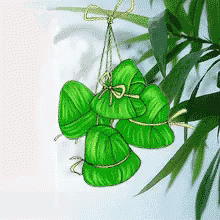
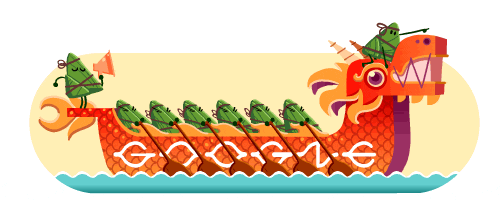


Dragon boat festival (Double Fifth Festival)
端午節是在農曆的五月五日,划龍舟(Dragon boat race)、吃粽子(Rice dumpling is wrapped with bamboo leaves) 、做香包 (To make fragrant sachet)、掛艾草(Hanging moxa) 、立蛋 (Standing the egg on its end) and 喝雄黃酒(Drinking realgar wine)
(Dragon Boat Festival, also known as Double Fifth Festival, is an important festival in our history and Dragon Boat Festival commemorates the death of the poet Chu Yuan. 端午節是為了紀念詩人屈原的死。)
and The last about 白蛇傳 Legend of the White Snake. ◠‿◠
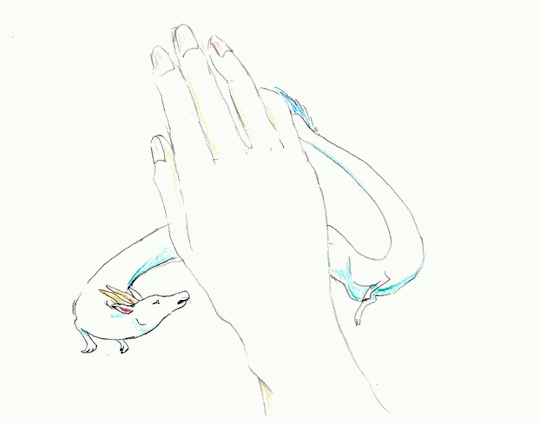





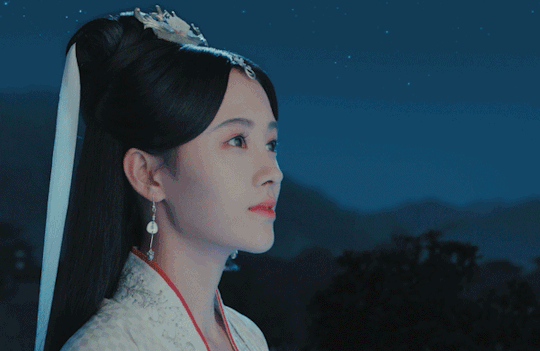
well, enjoy your holiday for 4 days(started yesterday) this year 2023 in Taiwan and Chinese world. My daughter go to solo traveling to Thailand again lol (I guessed she meet one elephant good friend so never tired. hahaha Her boyfriend is still in military service and will be retiring in a few days. I like her boyfriend, because he respects my daughter and he's gentle more than my daughter. XD) and my son enjoys to stay home. both children are different personality, really nice and interesting. and my holiday is a secret. hehe! HAPPY WEEKEND ALL. xoxo Lan~*
#dragon boat festival#double fifth festival#端午節#農曆五月五日#划龍舟#dragon boat race#吃粽子#rice dumpling is wrapped with bamboo leaves#做香包#to make fragrant sachet#掛艾草#hanging moxa#立蛋#standing the egg on its end#喝雄黃酒#drinking realgar wine
8 notes
·
View notes
Text
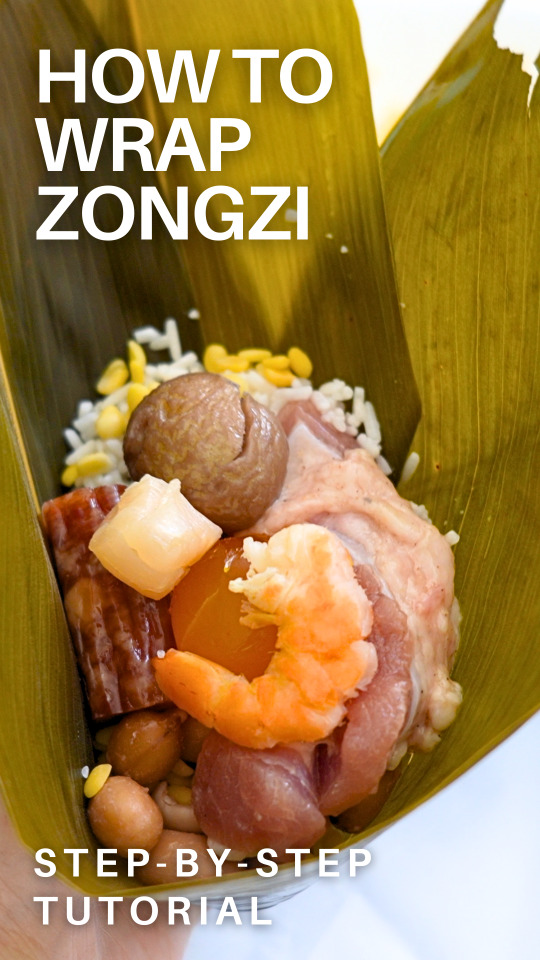
How to wrap Zongzi (Chinese Sticky Rice Dumplings) Step-by-step Tutorial
#zongzi#how to wrap zongzi#wrapping zongzi#chinese sticky rice dumplings#zongzi wrapping tutorial#joong#dragon boat festival#chinese food#chinese cuisine#chinese festivals#food pics#food blog#sikfankitchen#bamboo leaves
2 notes
·
View notes
Text
If all Zong Zi or Rice Dumplings look the same to you, you’re not alone! Zong Zi (粽子) or Bak Chang are a variety of glutinous rice dumplings traditionally eaten by the Chinese during the Dragon Boat Festival (端午节). Here are six types of popular Zong Zi from various dialect and ethnic groups in Singapore.
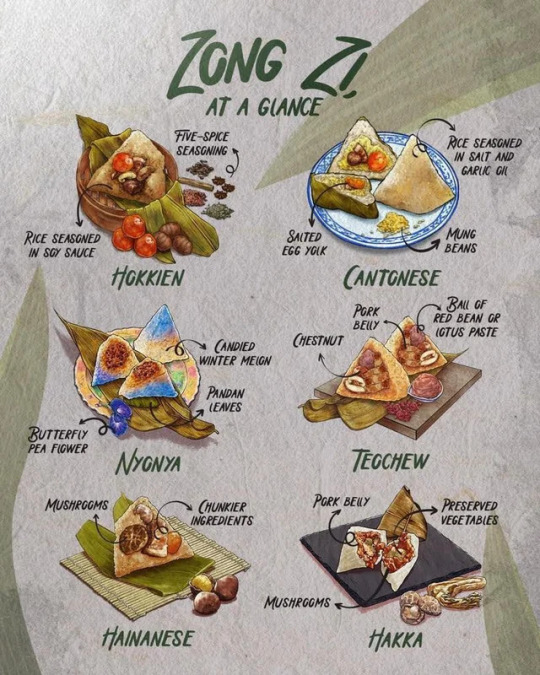
youtube
Hokkien Rice Dumpling (福建咸肉粽) - One of the most common Zong Zi that can be found in markets and stores, the Hokkien Zong Zi is wrapped in bamboo leaves is recognized by its dark appearance from soy sauce infused rice and distinct aroma from the five-spice seasoning. Usually made with pork belly, salted egg yolk, chestnuts and dried shrimps.

Cantonese Rice Dumpling (广东咸肉粽) - The ingredient that sets Cantonese Zong Zi apart is the filling of mung beans or green beans. One can also order a variation with a salted egg yolk. The glutinous rice is also seasoned with salt and garlic oil instead of soy sauce.

Nyonya Rice Dumpling (娘惹粽) - The Nyonya Zong Zi is the most distinguishable rice dumpling for its bright blue tip that is typically made from the extract of the butterfly pea flower. It is also sweeter in taste and aroma because of its pandan leaf wrapper and candied winter melon.

Teochew Rice Dumpling (潮州粽) - The savoury yet sweet taste of a Teochew Zong Zi comes from various ingredients such as red bean paste or lotus paste, fatty pork belly, earthy mushrooms and dried shrimp. Chestnuts are also added to the dumpling for texture.
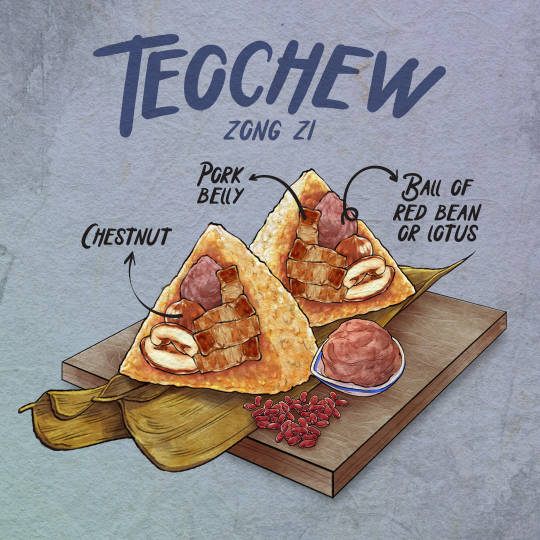
Hainanese Rice Dumpling (海南肉粽) - The Hainanese Zong Zi’s most distinctive trait lies in its portion. It is filled with generous chunks of pork belly, whole chestnuts, mushrooms, and seasonings of savoury additions like five-spice powder, dark soy sauce, and black pepper. It is also usually served with a dollop of palm sugar syrup, adding a nice balance of sweetness to its savoury and slightly spicy flavour.
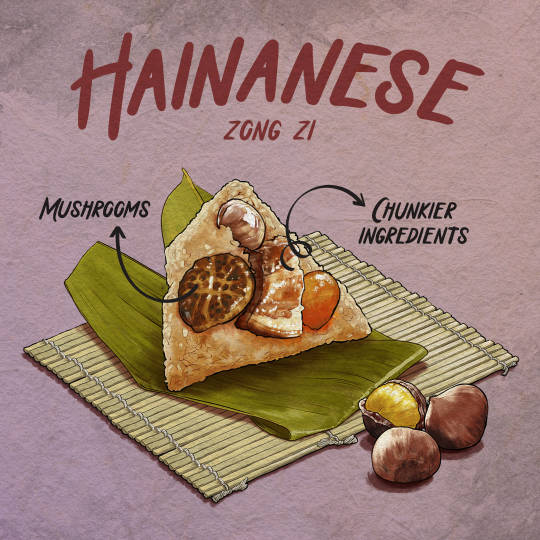
Hakka Rice Dumpling (客家粽) - Steamed in bamboo leaves, the Hakka Zong Zi consists of preserved vegetable filling, juicy pork belly strips and savoury mushrooms. It is also sometimes filled with beans.
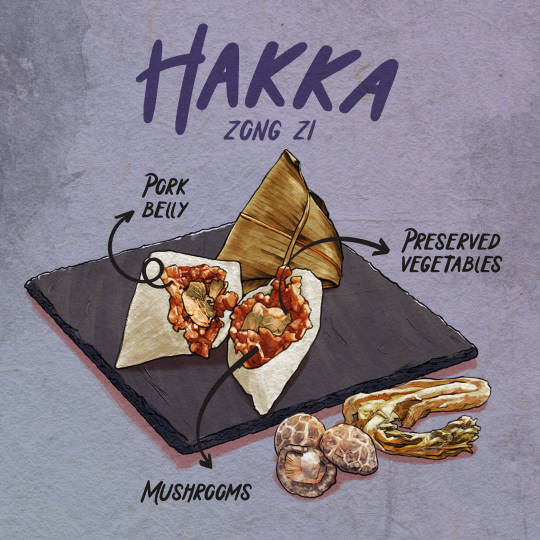
Zong Zi info from here and images from Ministry of Culture, Community and Youth.
#Dragon Boat Festival#端午节#农历五月初五#Rice Dumpling#粽子#Zong Zi#Hokkien Rice Dumpling#福建咸肉粽#Cantonese Rice Dumpling#广东咸肉粽#Nyonya Rice Dumpling#娘惹粽#Teochew Rice Dumpling#潮州粽#Hainanese Rice Dumpling#海南肉粽#Hakka Rice Dumpling#客家粽#Video#Youtube#Asian Food#Food#Buffetlicious
110 notes
·
View notes
Text
@galauvant happy new year!! may it bring you many ready-to-eat snacks and ingredients for thai home cooking
here's a little shopping list of some things i recommend getting if you go there:
oishi green tea kyoho grape with nata de coco: the first time i saw people drink this mid-romantic scene in a thai bl it was a bit jarring, but that was only because i hadn't tried it before. it's so lovely; i could write sonnets about it.
golden mountain seasoning sauce: you can get it elsewhere but they sell a liter of it for like $5, which is very worth it if you make garlic noodles or any thai stir fries regularly
dragonfly brand black soy sauce: for pad see ew! (the one with the orange cap. if you don't anticipate using it much, honestly you could probably up the soy sauce/add chinese black soy sauce and add a very small amount of molasses?)
ABC brand sweet soy sauce: a common malay and indonesian condiment. this is way too sweet for me but i had a roommate who put it on everything and felt like i should mention that they sell it!
big bags of glutinous rice for way less than you'd pay anywhere else
BAMBOO CONE STEAMER (หวด). THIS WILL CHANGE YOUR LIFE IF YOU LIKE STICKY RICE. it's like $6 if you have a pot that it will fit in, and still under $20 if you need to buy a pot to go with it. it is impossible to mess up sticky rice using this method. there is literally zero measuring required and it gives the rice such a nice fragrance. i've been able to make mango sticky rice on a whim every time i've seen a good deal on good mangoes the last couple of years and this is why. here is a video on how to make sticky rice with it! and here is a mango sticky rice recipe i use as a template. for 1 cup uncooked sticky rice i use one 8.5oz carton of aroy d coconut milk to ½ cup sugar and 1 tsp salt, then reserve a scant ½ cup of the dissolved coconut milk mixture for the sauce. (cornstarch works as a thickener if you don't have rice flour!)
frozen khanom thien (ขนมเทียน) there's a similar lao dessert called kanom nap, and a burmese dessert called mok phet thot. it's a steamed glutinous rice dumpling wrapped in banana leaves and filled with a caramelized shredded coconut/palm sugar filling! here are a handful of videos of people making it!
butterfly pea flowers: not cheap but i think still cheaper than i've seen them elsewhere?? relatedly! there is a thai restaurant on the UES that sells chor muang (ช่อม่วง). I think it was Thep on 75th and 2nd?? They're beautiful, interesting, and a pain to make, and I've never seen them on another restaurant menu.
frozen pandan leaves: not sure where else i would get them in nyc, although pretty much any SE asian grocery store will carry them.
makrut lime leaves: sometimes sold frozen, sometimes in a little ziploc bag in the refrigerated section. *girl scout cookie sales voice* they freeze well!
frozen galangal slices
fun lays flavors
nam prik pao (นำ้พริกเผา): if you don't eat shrimp, there's one vegetarian brand that uses dried shiitake mushroom for the savory element (Chua Hah Seng vegetarian chilli paste - นำ้พริกเผาฉั่วฮะเส็ง มังสวิรัติ)
palm sugar: available elsewhere, but usually more expensive
fresh/frozen coconut milk: worth trying at least once! it's also worth getting one or two shelf-stable cartons of coconut milk if you've only had canned before, but their prices aren't great—i usually get the 6- or 12-packs of 8.5 oz cartons of aroy d on amazon
they sell a little frozen tom yum veggie set with lemongrass, galangal, and lime leaves, which is nice if you're only planning to make it once or twice
sundried bananas (กล้วยตาก): they don't always carry these. sometimes they're vacuum packed; sometimes they have them in a little plastic clamshell container
If you're cooking for a vegetarian or someone with a shellfish allergy and looking at savory items, note that there are two words that get translated as "vegetarian," which are used somewhat interchangeably but strictly speaking mean different things—'je' (เจ) and 'mangsawirat' (มังสวิรัติ). เจ/je doesn't include onions, garlic and certain other vegetables. If you see something labeled as vegetarian curry paste, you'll want to check whether they just mean no shrimp paste, or no shrimp paste/garlic/shallots!! Items labeled as มังสวิรัติ/mangsawirat will not contain meat, shellfish, fish, or fish sauce, but can contain allium.
#disclaimer i am not thai just someone who cooks a lot!!!#sorry i can't comment or send messages from my main blog rn otherwise this would not be a post#cooking tag
4 notes
·
View notes
Text
How to Celebrate the Dragon Boat Festival: History, Culture and Customs

The Dragon Boat Festival (Duan Wu Jie) is a traditional Chinese festival that has been celebrated for over 2,000 years. It is held on the fifth day of the fifth lunar month, which usually falls in June on the Gregorian calendar. The festival has a rich history and culture that is celebrated in different ways across China and other parts of the world.
The most popular theory of the origin of the festival is that it was derived from the commemoration of a great patriot poet, Qu Yuan. Qu Yuan was a minister in the state of Chu during the Warring States period (475-221 BC). He was exiled by the king for opposing alliances with other states and committed suicide by drowning himself in the Miluo River. The local people who admired him raced out in boats to save him or retrieve his body. They beat drums and splashed their paddles in the water to scare away fish and evil spirits. This is said to be the origin of dragon boat racing.

The Dragon Boat Festival is celebrated in different ways across China. In southern China, especially in Guangdong, Hong Kong, and Macau, people eat zongzi (sticky rice dumplings) wrapped in bamboo leaves. The fillings can vary from sweet to savory and include pork belly, salted egg yolk, mushrooms, chestnuts, and red bean paste. In northern China, people eat wheat dumplings called jiaozi instead.
Dragon boat racing is another popular activity during the festival. It involves teams of paddlers racing dragon-shaped boats to the beat of drums. The races are held on rivers or lakes and are accompanied by loud cheers and applause from spectators.

The Dragon Boat Festival has become an important cultural event around the world. It is celebrated in many countries including Singapore, Malaysia, Vietnam, Korea, Japan, and the United States. In addition to dragon boat racing and eating zongzi, other activities include making sachets filled with herbs to ward off evil spirits and hanging calamus and wormwood leaves on doors to repel insects.
I hope this information helps you understand more about this wonderful festival! Let me know if you have any other questions or if there’s anything else I can help you with.
This is another blog post I wrote in French. If you are interested, please click to read https://teaware.over-blog.com/
4 notes
·
View notes
Note
because of the concubine au... top 5 chinese desserts?
Making or eating? In no particularly order...
Eating: Tangyuan (aka glutinous rice ball) with jiuniang, hawthorn flake candy, zongzi (aka rice dumpling wrapped in bamboo leaves), any flaky pastry to be honest, sesame ball
Making: sesame brittle, milk bread, nian gao, castella, and... does dango count even though it's japanese and is basically a tangyuan without filling?
[prompt]
10 notes
·
View notes
Text
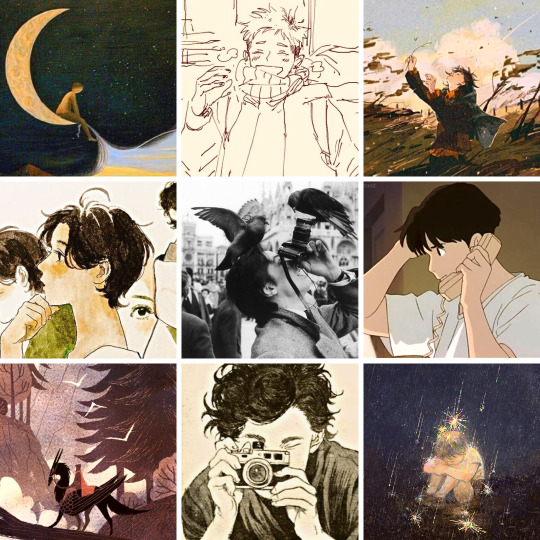
jinliang (galen):
general stats: 178cm tall, 20 years old
studies: westfarland classical studies (specialization: combined literature & oral tradition), faculty of storytelling arts, third year
favourite food: roasted sweet potatoes, beef soup, zongzi (sticky rice dumplings wrapped in bamboo leaves), fengli su (pineapple cake)..... Galen will just about eat anything, though.
favourite family member: his immediate family. Galen is less attached to his extended family because of Family Tensions
would probably love: 19th century Russian writers, Polaroid cameras, theology school, world history, the idea of "doing little things with great love", martial arts, St. Francis, G.K. Chesterton, Studio Ghibli, the idea of instant noodles but maybe not the actual taste, Peggy Carter & Martha Jones & Donna Noble, reading poetry out loud, small children, going out on walks, impromptu music sessions with friends, the niche little corner of poet-priests (Gerard Manley Hopkins, George Herbert, Malcolm Guite, etc.), card games, Wodehouse books... he probably watched Roman Holiday and cried
current concern: aside from the family prophecy, Galen is worried that he spends too much money on books. (This is not an unreasonable fear. He does.)
#i hope there's a marked difference between petra and galen's moodboards because there's supposed to be#there is a lot of joy and wonder in galen's life despite the troubles and worries which is why most of his pictures are in colour#anyhow i really overthought this but here we are#i also think that galen would be an excellent babysitter and a decent poet himself :)#round 2: songbird's inklings challenge story
18 notes
·
View notes
Text
Taj Mahal Sunrise tour from Delhi By Taj Same Day Tour Company
The Taj Mahal Sunrise Tour from Delhi, offered by Taj Same Day Tour Company, is a popular choice for visitors who want to see the Taj Mahal at dawn. Here's a summary of what such a tour usually covers and what you may anticipate:
Tour Overview Taj Mahal Sunrise Tour from Delhi,
Early Morning Departure: The tour normally begins very early in the morning (about 2-3 a.m.) to assure arrival to the Taj Mahal before sunrise. The travel from Delhi to Agra takes about 3-4 hours.
A private car or coach will take you up from your hotel or a pre-arranged place in Delhi. The vans are normally air-conditioned and comfortable during the travel.
Professional Guide: A professional guide will accompany you to Agra and provide historical context for the Taj Mahal and other places you visit.
Visit the Taj Mahal: Arrive at sunrise to see its breathtaking splendor in the warm morning light. The early morning visit allows you to avoid the crowds and heat of the day.
Breakfast: Following your visit to the Taj Mahal, you will normally eat breakfast at a local restaurant or hotel in Agra.
Additional sightseeing:
Agra Fort: Following breakfast, the tour typically continues with a visit to Agra Fort, a UNESCO World Heritage site and important medieval fort in India.
Optional Sites: Depending on the plan, you may be able to visit other sights such as the Tomb of Itimad-ud-Daulah (Baby Taj) or Mehtab Bagh to get a different perspective of the Taj Mahal.
Return to Delhi: After seeing the sites in Agra, you will be transported back to Delhi. The return travel normally gets you back to Delhi by late afternoon or early evening.
Drop-off: You will be dropped off at your hotel or a specific place in Delhi.
The tour includes round-trip transportation from Delhi to Agra and return.
Entrance fees to the Taj Mahal and Agra Fort.
Professional guiding services.
Breakfast in Agra.
The car contains bottled water and refreshments.
What to bring.
Comfortable walking shoes.
Sunscreen, sunglasses, and a hat.
For photography, use a camera or your smartphone.
Entrance tickets require a valid ID.
Booking Tips:
Advance booking is essential, especially during peak tourist seasons.
Check reviews: Look for tour company reviews and ratings to ensure a high-quality experience.
Customize your tour: Some tour operators may let you personalize your schedule based on your preferences.
ALSO READ-
The Dragon Boat Festival, also known as the Duanwu Festival, is a traditional Chinese event celebrated on the fifth day of the fifth month of the Chinese lunar calendar. Here are some main features of the festival:
Historical Background.
The Dragon Boat Festival honors the death of Qu Yuan, a well-known Chinese poet and minister from the Warring States period. Qu Yuan drowned himself in the Miluo River on the fifth day of the fifth lunar month. According to folklore, locals raced out in their boats to save him or retrieve his body, and this is thought to be the genesis of dragon boat races.
Key Traditions
Dragon Boat Racing is the festival's most iconic activity. Teams paddle ornately adorned dragon boats to the beat of drums, competing against one another in a display of strength, speed, and synchronization.
Zongzi are pyramid-shaped glutinous rice dumplings wrapped in bamboo or reed leaves and typically filled with sweet or savory ingredients such Chinese red bean paste, dates, or pork. This tradition is tied to attempts to safeguard Qu Yuan's body by feeding rice dumplings to fish in the river.
People frequently hang Calamus and Mugwort on their doors to keep off evil spirits and insects. Calamus and mugwort are thought to possess cleaning and protecting effects.
Drinking Realgar Wine: Realgar wine is traditionally consumed to ward off disease and evil spirits. Realgar is a form of arsenic sulfide, and while this practice is no longer common because to its toxicity, it was once an important feature of the festival.
Tying Five-Color Silk Threads: Parents frequently wrap five-color silk threads around their children's wrists, ankles, or necks to protect them from evil spirits and diseases. These threads are typically not eliminated until a rainstorm washes them away.
Cultural Significance
The Dragon Boat Festival is culturally significant, representing Qu Yuan's valor and loyalty as well as the community spirit of the dragon boat races. It also represents the ancient Chinese people's bond with nature, as well as their use of traditional rituals to protect their health and well-being.
Modern celebrations
Today, the Dragon Boat Festival is celebrated not just in China, but also in other nations with large Chinese populations. It has become a time for family reunions, cultural performances, and athletic competitions. The festival was designated as an Intangible Cultural Heritage by UNESCO in 2009, underlining its global cultural significance.
1 note
·
View note
Text
Chinese sticky rice dumplings, known as zongzi, are a traditional food made of glutinous rice stuffed with various fillings and wrapped in bamboo or reed leaves. They are typically enjoyed during the Dragon Boat Festival, which falls on the fifth day of the fifth month of the Chinese lunar calendar. This festival commemorates the ancient Chinese poet and minister Qu Yuan, who drowned himself in protest against government corruption. Villagers, trying to save him or at least preserve his body, threw rice dumplings into the river to keep fish from eating it.
0 notes
Text

端陽樂 日日安好/Happy Dragon boat festival (Double Fifth Festival)
端午節是在農曆的五月五日,划龍舟(Dragon boat race)、吃粽子(Rice dumpling is wrapped with bamboo leaves) 、做香包 (To make fragrant sachet)、掛艾草(Hanging moxa) 、立蛋 (Standing the egg on its end) and 喝雄黃酒(Drinking realgar wine)
(Dragon Boat Festival, also known as Double Fifth Festival, is an important festival in our history and Dragon Boat Festival commemorates the death of the poet Chu Yuan. 端午節是為了紀念詩人屈原的死。)
Tonight I’m having "東方美人茶(Oriental Beauty Tea)" 🍵 🫖Tea for you Dear friends, Please!

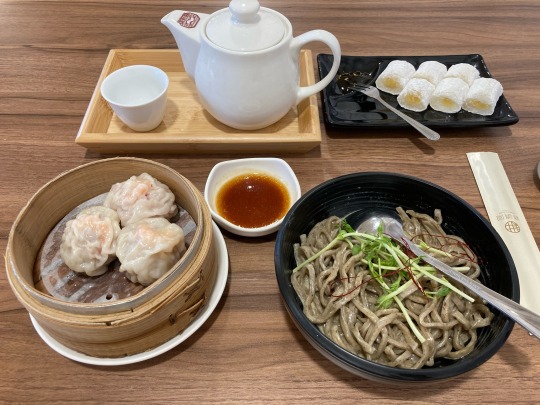

👆 椒麻麵 the noodle tastes good on this restaurant (非常素食的麵 🫶 其實,平日的我本來就像和尚一樣 🤣,吃的很清淡也很簡單,因爲吃的越素,可以降低生活中的各種「慾望」和渴求。Very vegetarian noodles 🫶 In fact, I am like a monk 🤣 on weekdays, eating very light and simple, because the more vegetarian I eat, the less "desires" and cravings I have in life.) 😏 and very years ago this restaurant ever opened shop near by my studio, but rent cost too high, they're moved to other city, I found it re-open at the north parts of my city, so tonight I am so happy to eat the noodle again. 😃 Lan~*
👇 鮮蝦燒賣 Pork & Prawn Shumai (taste a bit similar with dumplings. and I love having "steamed food/蒸食" 😉)






#chu lan#fine craft artist#朱蘭皮藝#leather art artist#beautiful life#ㄧ個人的生活#靜心#Taiwan artist city life#eat love laugh
52 notes
·
View notes
Text
Unity is Strength: Making a Bunch of Rice Dumplings

The Dragon Boat Festival is coming. To celebrate this holiday, Chinese people would eat zongzi or rice dumpling. Dharma Master Cheng Yen says that Dharma can be found in everything, even in rice dumplings. Since 2017, Master began to use rice dumpling as a metaphor for how Tzu Chi and its volunteers and staff should operate.
In society, there are many people in suffering, so a lot of work needs to be done to help people in need. Yet, resources in society, such as material goods, manpower, funds, etc., are scattered. In order to help people, there’s a need to pool society’s resources together. This is what Tzu Chi is doing. It’s like making rice dumplings.
To make rice dumplings, we first make a bundle of strings by tying a knot at the top. The strings are for tying individual rice dumpling. Each rice dumpling is made by wrapping glutinous rice and fillings in bamboo leaves and tying it with a string to maintain its pyramid shape. With the strings connected to the knot, the rice dumplings are tied together neatly in a bundle.



There are many kindhearted people in society who are willing to help people, so there’s a need to bring these kindhearted people and their strength together. The ingredients of rice dumpling are like the resources in society, such as people’s love, donors, donations, material goods, etc. There are people in society who do not know Tzu Chi and what it does. Tzu Chi volunteers’ responsibility is to tell people about Tzu Chi and inspire love in people. Volunteers are like the bamboo leaves wrapping the ingredients together by gathering society’s resources, soliciting donations from donors and bring people’s love together.
The knot is like the spirit and values of Tzu Chi, the guiding principles of how Tzu Chi should function. Tzu Chi’s spirit and values come from Master’s teachings and the Buddha’s teachings. There’s a need to form a solid knot so that Tzu Chi volunteers and staff can have a clear understanding of Tzu Chi’s guiding principles and carry out Tzu Chi’s missions with these principles through various functional teams and division of work.

The strings are like the organizational structure of Tzu Chi, which includes Tzu Chi staff and Tzu Chi volunteer team leaders. The strings connect the rice dumplings to the knot. In Tzu Chi’s volunteer structure, the team leaders are like the strings, keeping the bamboo leaves in shape and connecting all the rice dumplings together. With the strings, we can hold up a bunch of rice dumplings by the knot. This is like gathering together society’s scattered resources, such as Tzu Chi’s donating members, donations, Tzu Chi volunteers, Tzu Chi team leaders, and link them to the knot, which is Dharma Master Cheng Yen and her teachings. Each rice dumpling can also be like a functional team. It’s through the string that they are connected to the knot. Without the Dharma as guiding principles, each functional team might go astray as they carry out their work. So, the string plays an important function of connecting the leaves to the knot.
The Dharma and Master’s teachings are the core and spirit of Tzu Chi. If each of the strings do not want to be connected to the knot, to Tzu Chi’s Dharma, over the course of time, Tzu Chi’s spirit and values will fade and its strength will wane. Master encourages Tzu Chi volunteers around the world to learn more about the Dharma so that they can all be guided by the Dharma and bring people’s strength together.
To contribute to society and help people in suffering, there’s a need to form an organization that has strength and spirit. Tzu Chi is a very orderly and organized organization. The metaphor of making a bunch of rice dumplings displays Tzu Chi’s spirit of unity. Volunteers are to work together in unity and harmony with love. If the hearts of all volunteers are united and what they do is correct and does not deviate from principles, this is embodying the spirit of a bunch of dumplings.
We can all be like a bunch of rice dumplings. We try to make as many rice dumplings as we can by inspiring love in many people, share the Dharma with them, and gather resources together. When people in society practice the Dharma and pool resources together to help people in need, together, we are protecting our society and the people in our society.

1 note
·
View note
Text
Why is it the Chinese personalized to eat rice dumplings 粽子 ?
The Chinese custom made of eating rice dumplings, often called zongzi (粽子), is deeply rooted in custom and record. These pyramid-formed glutinous rice parcels are Patchun Store Dumplings typically wrapped in bamboo leaves and stuffed with various components for example pork, mushrooms, and salted egg yolk.
The tradition of eating rice dumplings is affiliated with the Dragon Boat Pageant, also known as Duanwu Pageant, which falls within the fifth day on the fifth lunar month. The Pageant commemorates the Loss of life of Qu Yuan, a patriotic poet and minister from your Warring States period of historical China.
Legend has it that when Qu Yuan drowned himself while in the Miluo River being a method of protest versus corruption, local folks rushed on the river to save lots of him. To stop fish and evil spirits from consuming his overall body, they threw rice dumplings in the river as choices. This act of making and consuming rice dumplings became a means to honor Qu Yuan's sacrifice and push back evil spirits.
After some time, the tradition progressed into a cultural follow observed throughout the Dragon Boat Festival, where by family members Get to produce and luxuriate in rice dumplings jointly. It symbolizes unity, remembrance of ancestors, as well as pursuit of good fortune and blessings. These days, rice dumplings remain an essential Element of Chinese culinary heritage and cultural celebrations.
1 note
·
View note
Text



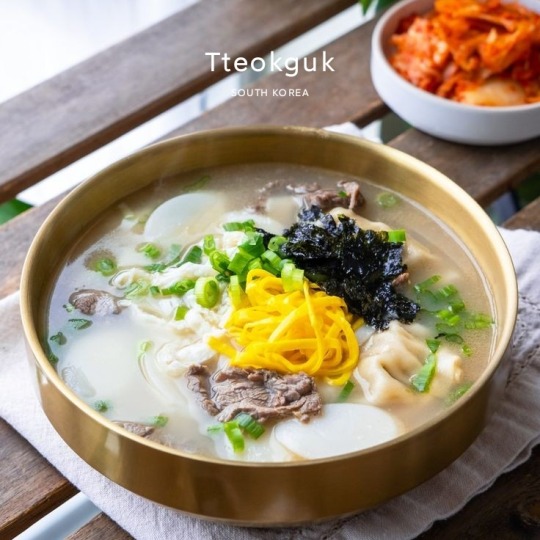


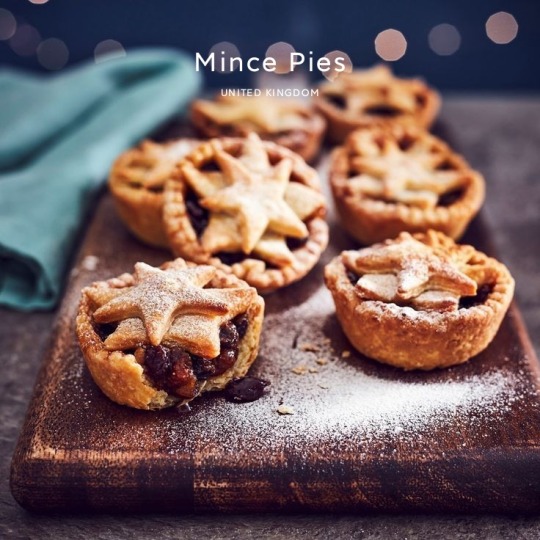



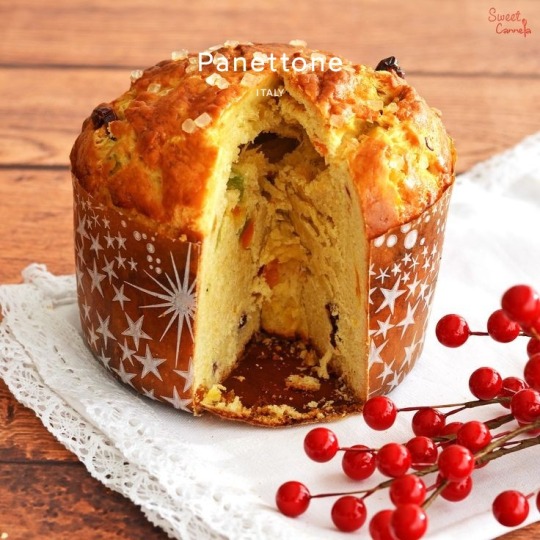

Traditional Holiday Dishes From Around The World
Food is such a wonderful way to experience different cultures, especially during the holiday season. Here are a few traditional holiday dishes from around the world:
Puto Bumbong (Philippines): This is a type of steamed rice cake that's traditionally made during the Christmas season. It's purple in color and is usually served with a sprinkle of brown sugar and shredded coconut.
Daifuku Mochi (Japan): This is a type of rice cake that's often enjoyed during New Year's celebrations. It can be sweet or savory, depending on the filling.
Turron (Spain): Turron is a traditional Spanish Christmas dessert made with almonds, honey, and egg whites. It has a nougat-like texture and comes in various flavors, such as almond, chocolate, and fruit.
Panettone (Italy): This is a sweet bread loaf originating from Milan, typically prepared and enjoyed for Christmas and New Year. It has a cupola shape, with a soft and airy interior beneath a dark exterior. The dough is cured for several days to give it its distinctive fluffy characteristics.
Tteokguk (South Korea): This is a soup made with sliced rice cakes, usually eaten during the Korean New Year. It's a comforting and hearty dish.
Biryani (India): This is a flavorful rice dish made with spices, meat (like chicken or mutton), and sometimes, hard-boiled eggs. It's often served during special occasions and festivals.
Tamales (Mexico): These are a traditional Mesoamerican dish made of masa (a dough made from corn) that's filled with meats, cheeses, fruits, or chilies, wrapped in a corn husk and then steamed. They're often made for special occasions and holidays like Christmas.
Pavlova (Australia): This is a meringue-based dessert named after the Russian ballerina Anna Pavlova. It's crisp on the outside and soft and light inside, usually topped with fruit and whipped cream. It's often served during Christmas celebrations.
Zongzi (Taiwan): This is a traditional dish for the Dragon Boat Festival. The dumplings are made from glutinous rice filled with a variety of ingredients like pork, mushrooms, and chestnuts, then wrapped in bamboo leaves and steamed.
Lo Bak Go (HongKong): This is a traditional dish served during Chinese New Year. It's made from shredded radish and rice flour, and often contains bits of dried shrimp or sausage.
Glühwein (Germany): This is a spiced mulled wine that's traditionally enjoyed during the Christmas season. It's made with red wine, citrus fruits, and a blend of spices like cloves and cinnamon.
Mince Pies (United Kingdom): These are small British sweet pies traditionally served during the Christmas season. Their ingredients are traceable to the 13th century, when returning European crusaders brought with them Middle Eastern recipes containing meats, fruits, and spices.
Isn't it fascinating how each country has its unique holiday traditions? Do you have a favorite holiday recipe? 🍽️🌍
Image sources:
https://foxyfolksy.com
https://pin.it/5C2VruB
https://spainonafork.com
https://pin.it/SNiSvqR
https://thewoksoflife.com
https://oetker.co.uk
https://pin.it/3Hn5Rer
https://www.lebkuchen-schmidt.com
https://cookerru.com
https://sweetcannela.com
https://roadfood.com
https://pin.it/27HuYBR
0 notes
Text
The Unique Cuisine of Arunachal Pradesh: A Culinary Journey Through the Land of Mysteries
Nestled in the remote northeastern corner of India, Arunachal Pradesh is a land of unparalleled natural beauty and cultural diversity. This picturesque state is not only known for its stunning landscapes but also for its distinctive and flavorsome cuisine. The cuisine of Arunachal Pradesh is a hidden gem waiting to be discovered by food enthusiasts and travelers alike. In this article, we will embark on a culinary journey through the unique cuisine of Arunachal Pradesh, exploring its rich cultural heritage and the delightful dishes that make it truly exceptional. Explore the beauty of Arunachal Pradesh with our taxi service in Tawang.
A Blend of Flavors
Arunachal Pradesh is home to more than 26 distinct tribes, each with its own unique traditions and culinary practices. This rich tapestry of cultures has given rise to a diverse cuisine that reflects the state's multicultural identity. The cuisine of Arunachal Pradesh draws inspiration from its neighboring states and countries, including Tibet, Bhutan, and Myanmar, resulting in a harmonious blend of flavors and ingredients.
Key Ingredients
Rice: Rice is the staple food of Arunachal Pradesh and forms the base of most meals. Varieties of rice, such as sticky rice and red rice, are commonly consumed.
Meat: Being a predominantly non-vegetarian cuisine, meat plays a central role. Pork, beef, chicken, and fish are the most commonly consumed meats, and they are prepared in various ways.
Leafy Greens: The state boasts a rich variety of leafy greens and herbs that are used in both fresh and fermented forms. Bamboo shoots are a favorite accompaniment to many dishes.
Chillies: Arunachal Pradesh is known for its love of spicy food. Chillies are used liberally in many dishes, adding a fiery kick to the flavors.
Local Spices: Aromatic spices such as ginger, garlic, and Sichuan pepper are frequently used to enhance the taste of dishes.
Distinctive Dishes
Thukpa: Inspired by Tibetan cuisine, Thukpa is a hearty noodle soup that is perfect for the chilly weather in Arunachal Pradesh. It is made with meat, vegetables, and aromatic spices, creating a warming and flavorful dish.
Momos: These dumplings are a beloved snack in Arunachal Pradesh and are typically filled with minced meat or vegetables. They are often served with spicy chutneys for an extra kick.
Gyapa Khazi: This traditional dish features smoked meat, which is cooked to perfection over an open fire. The smoky flavor and tender texture make it a favorite among locals.
Thukpa Raksi: A unique combination of Thukpa soup and Raksi, a local alcoholic beverage, this dish is a comforting and warming meal.
Zan: Zan is a porridge made from millets and is often eaten as a breakfast dish. It is usually served with fermented bamboo shoots and is a nutritious start to the day.
Poora Mach: This Assamese-influenced dish consists of marinated fish, typically freshwater varieties, wrapped in banana leaves and cooked to perfection. It is a true delight for seafood lovers.
Cultural Significance
Food in Arunachal Pradesh is more than just sustenance; it is deeply intertwined with the cultural fabric of the state. Many traditional festivals and ceremonies revolve around the preparation and sharing of special dishes. The act of cooking and eating is seen as a way to strengthen bonds within families and communities.
Conclusion
The cuisine of Arunachal Pradesh is a reflection of the state's rich cultural diversity and natural abundance. Its unique blend of flavors, influenced by neighboring regions, makes it a culinary treasure waiting to be explored. From spicy delicacies to hearty soups, the dishes of Arunachal Pradesh offer a tantalizing experience for food enthusiasts. So, the next time you find yourself in this enchanting state, be sure to embark on a culinary journey through the unique and flavorful cuisine of Arunachal Pradesh. Your taste buds will thank you for the adventure.
0 notes
Text

Svg: https://www.behance.net/gallery/174211521/Rice-ball-wrapped-in-bamboo-leaves-%28Rice-dumpling%29?
POD product: https://www.redbubble.com/people/TsouCyAdams/explore?asc=u&page=1&sortOrder=recent
#illustration#vector#cute#fun#art#food#redbubble#chinese characters#rice dumpling#rice ball#Chinese character#dragon boat festival#Chinese#svg#Behance
0 notes
Text

The Dragon Boat Festival, also known as Duanwu Festival or Zhongxiao Festival, is a traditional Chinese holiday that is celebrated on the fifth day of the fifth month of the lunar calendar, which usually falls in June. The festival has a history of over 2,000 years and is widely celebrated in China and other East Asian countries.
The Dragon Boat Festival has its origins in ancient China and is based on the legend of Qu Yuan, a famous poet and statesman during the Warring States period. Qu Yuan was a loyal minister who drowned himself in a river as a protest against government corruption and oppression. The people admired him and threw rice dumplings into the river to prevent the fish from eating his body. This act eventually evolved into the tradition of making and eating zongzi, a traditional Chinese sticky rice dumpling wrapped in bamboo leaves.
The main customs and activities during the Dragon Boat Festival include dragon boat races, eating zongzi, and hanging up pouches of herbs. Dragon boat races are one of the highlights of the festival and are held in rivers, lakes, and other bodies of water. These races involve teams of rowers paddling in long, narrow boats decorated like dragons.
Zongzi, the traditional food of the Dragon Boat Festival, is made by wrapping glutinous rice and various fillings such as beans, meats, and nuts in bamboo leaves. The zongzi is then steamed or boiled until cooked, resulting in a delicious and fragrant treat.
Another custom is to hang up pouches of herbs called "Artemisia sachets" or "Ai Ye" in Chinese. These pouches are believed to ward off evil spirits and protect people from diseases.
The Dragon Boat Festival is a time for family and friends to come together, pay respects to ancestors, and enjoy traditional activities. It is also recognized as a public holiday in China, and people often have time off from work or school to celebrate.
In addition to its cultural significance, the Dragon Boat Festival was inscribed on the UNESCO Intangible Cultural Heritage list in 2009, highlighting its importance and recognition on a global scale.
#edisonmariottiEdison MariottiEdison Mariotti
link: https://shre.ink/l3ju
.br
O Festival do Barco do Dragão, também conhecido como Festival Duanwu ou Festival Zhongxiao, é um feriado tradicional chinês que é comemorado no quinto dia do quinto mês do calendário lunar, que geralmente cai em junho. O festival tem uma história de mais de 2.000 anos e é amplamente comemorado na China e em outros países do Leste Asiático.
O Dragon Boat Festival tem suas origens na China antiga e é baseado na lenda de Qu Yuan, um famoso poeta e estadista durante o período dos Reinos Combatentes. Qu Yuan era um ministro leal que se afogou em um rio como um protesto contra a corrupção e a opressão do governo. As pessoas o admiraram e jogaram bolinhos de arroz no rio para evitar que os peixes comessem seu corpo. Esse ato acabou evoluindo para a tradição de fazer e comer zongzi, um tradicional bolinho de arroz pegajoso chinês envolto em folhas de bambu.
Os principais costumes e atividades durante o Festival do Barco-Dragão incluem corridas de barcos-dragão, comer zongzi e pendurar bolsas de ervas. As corridas de barcos-dragão são um dos destaques do festival e são realizadas em rios, lagos e outros corpos d'água. Essas corridas envolvem equipes de remadores remando em barcos longos e estreitos decorados como dragões.
Zongzi, a comida tradicional do Festival do Barco-Dragão, é feito envolvendo arroz glutinoso e diversos recheios como feijão, carnes e nozes em folhas de bambu. O zongzi é então cozido no vapor ou fervido até ficar cozido, resultando em uma guloseima deliciosa e perfumada.
Outro costume é pendurar bolsas de ervas chamadas "sachês de artemísia" ou "Ai Ye" em chinês. Acredita-se que essas bolsas afastam os maus espíritos e protegem as pessoas de doenças.
O Dragon Boat Festival é um momento para a família e os amigos se reunirem, prestarem homenagem aos ancestrais e desfrutarem de atividades tradicionais. Também é reconhecido como um feriado na China, e as pessoas costumam ter folga do trabalho ou da escola para comemorar.
Para além do seu significado cultural, o Dragon Boat Festival foi inscrito na lista do Património Cultural Imaterial da UNESCO em 2009, evidenciando a sua importância e reconhecimento à escala global.
0 notes